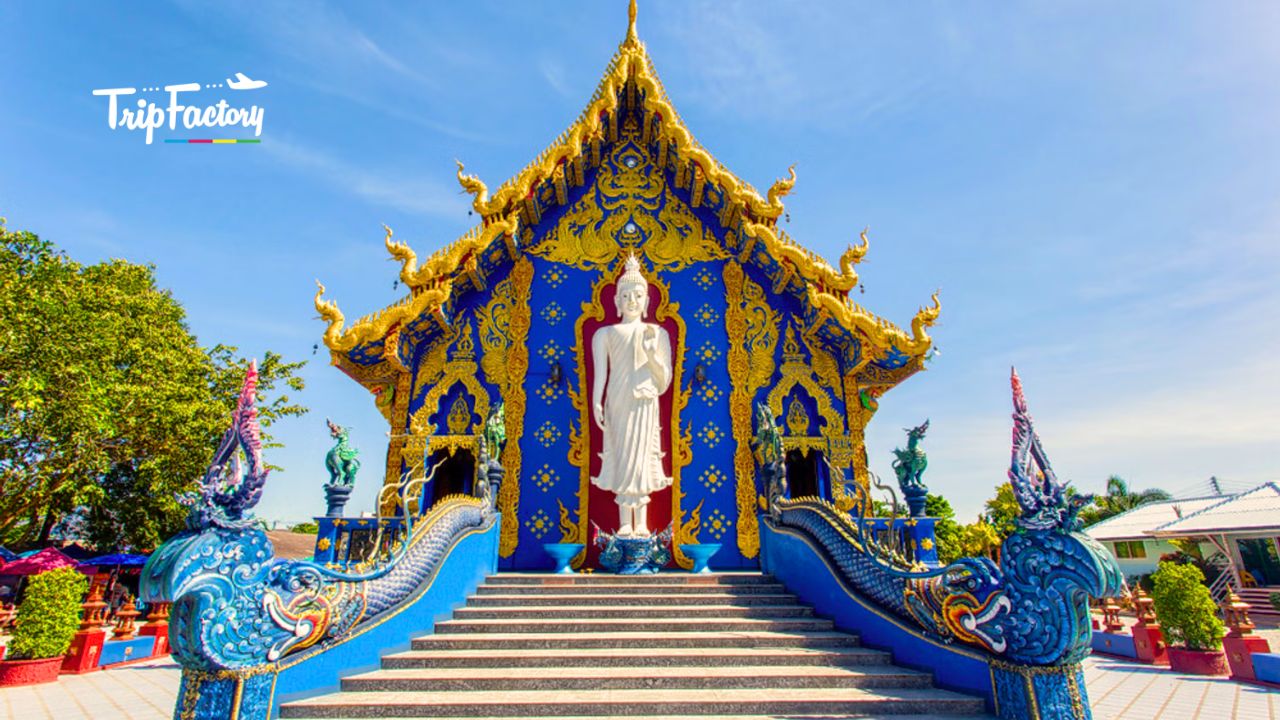Chiang Rai, located in the northernmost region of Thailand, is often overshadowed by its more famous neighbor, Chiang Mai. However, this charming city is a treasure trove of history, culture, and stunning natural beauty. Whether you’re an adventure seeker, a history buff, or someone looking for peaceful relaxation, Chiang Rai has something for everyone. Let’s explore some of the Places to visit in Chiang Rai.
Table of Contents
Here is the best Places to visit in Chiang Rai
The White Temple (Wat Rong Khun)
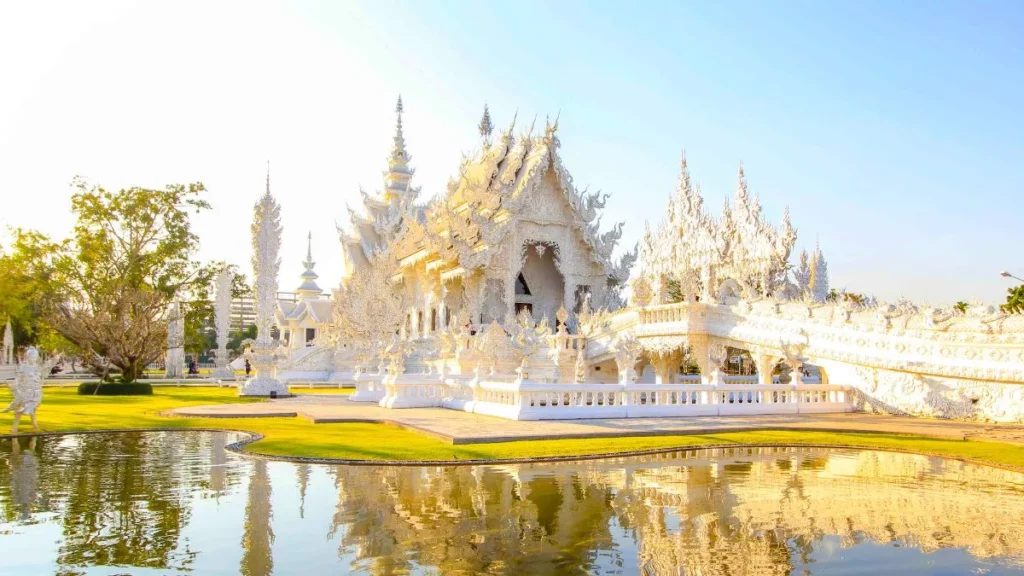
Undoubtedly the most famous landmark in Chiang Rai, the White Temple (Wat Rong Khun) is a modern masterpiece that looks like it came straight out of a fantasy. Designed by Thai artist Chalermchai Kositpipat, this temple is unique because it combines traditional Thai architecture with contemporary art. The white color symbolizes purity, while the intricate details and sculptures tell stories of Buddhist philosophy, human suffering, and the path to enlightenment.
Visitors can explore the temple’s stunning interior, which includes murals that merge traditional Buddhist imagery with modern pop culture references, such as depictions of Superman and Star Wars characters. The White Temple is a must-see for its beauty and artistic innovation.
- Highlights: The White Temple is known for its striking, all-white design, intricate murals, and a unique blend of traditional and modern art.
- What to Do: Take a guided tour to understand the symbolism behind the artwork and the murals. Visit the museum to learn more about the temple’s creation.
- When to Visit: Morning or early afternoon to avoid the crowds and enjoy the peaceful atmosphere.
The Blue Temple (Wat Rong Suea Ten)
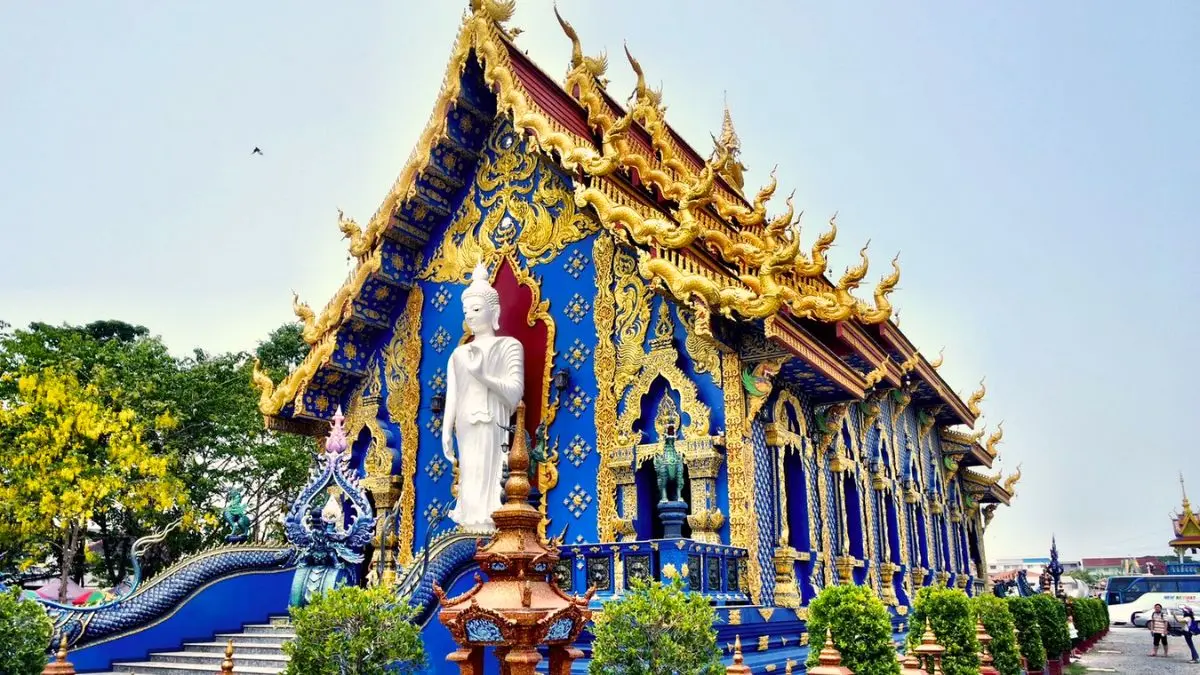
Another must-visit spot among the places to visit in Chiang Rai is the Blue Temple (Wat Rong Suea Ten). Known for its striking blue color, this relatively new temple, completed in 2016, is a beautiful contrast to the White Temple. The Blue Temple’s interior features intricate blue patterns and murals, with a large white Buddha statue sitting majestically in the center, adding a sense of calm and reverence. Its vibrant blue walls and stunning craftsmanship make it an excellent stop after visiting the White Temple.
- Highlights: The stunning blue and gold architecture, a massive Sitting Buddha statue, and the intricate murals that decorate the temple.
- What to Do: Explore the temple’s vibrant murals and statues. Take time to meditate or reflect in the quiet surroundings.
- When to Visit: Late afternoon, as the light creates a beautiful contrast with the blue temple, or visit early to avoid crowds.
Also Read: Places to Visit in Bangkok
The Golden Triangle
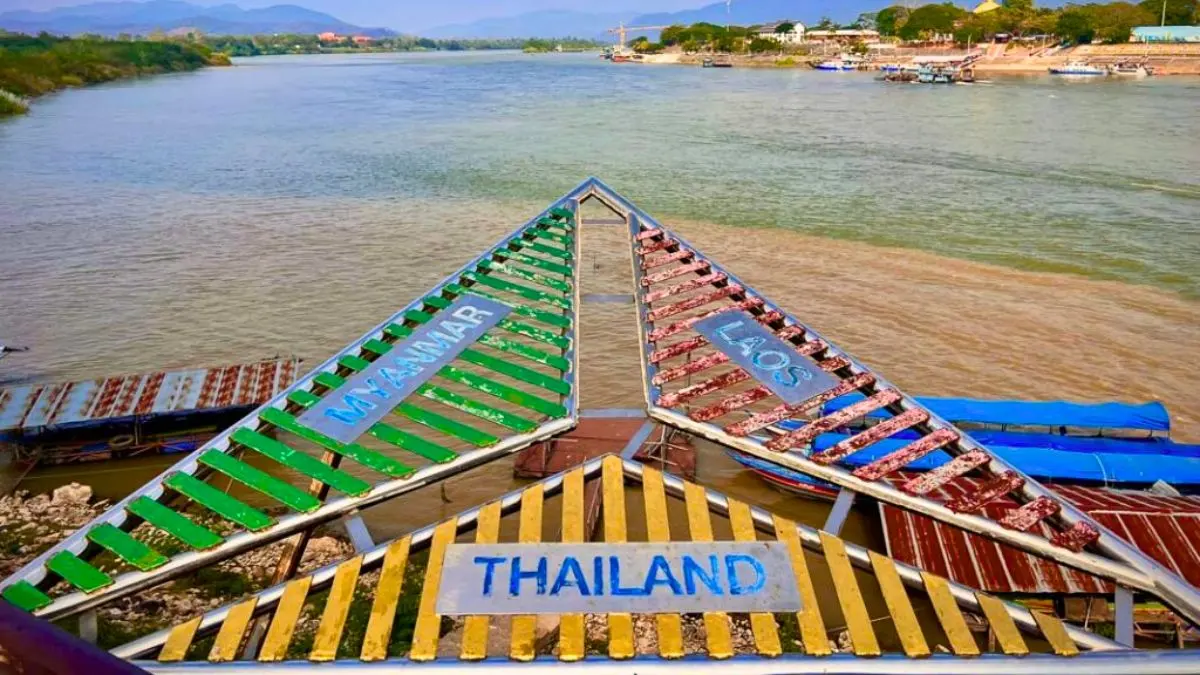
Located where the borders of Thailand, Laos, and Myanmar meet, the Golden Triangle is a region steeped in history and natural beauty. This area was once notorious for its role in the opium trade, but today it offers visitors scenic views and historical insights. The Golden Triangle viewpoint allows you to see the confluence of the Mekong and Ruak rivers, and you can take a boat ride to explore the surrounding areas.
Additionally, there are several historical sites to visit, including the Hall of Opium Museum, which offers an educational experience about the region’s opium history and its impact on the local communities.
- Highlights: The meeting point of Thailand, Laos, and Myanmar at the confluence of the Mekong and Ruak Rivers. Visit the Hall of Opium Museum for historical insights.
- What to Do: Take a boat ride along the river to explore the Golden Triangle. Visit the Opium Museum and learn about the region’s historical importance.
- When to Visit: Morning or early afternoon to avoid the midday heat, and to have a pleasant boat ride.
Baan Dam Museum (Black House)
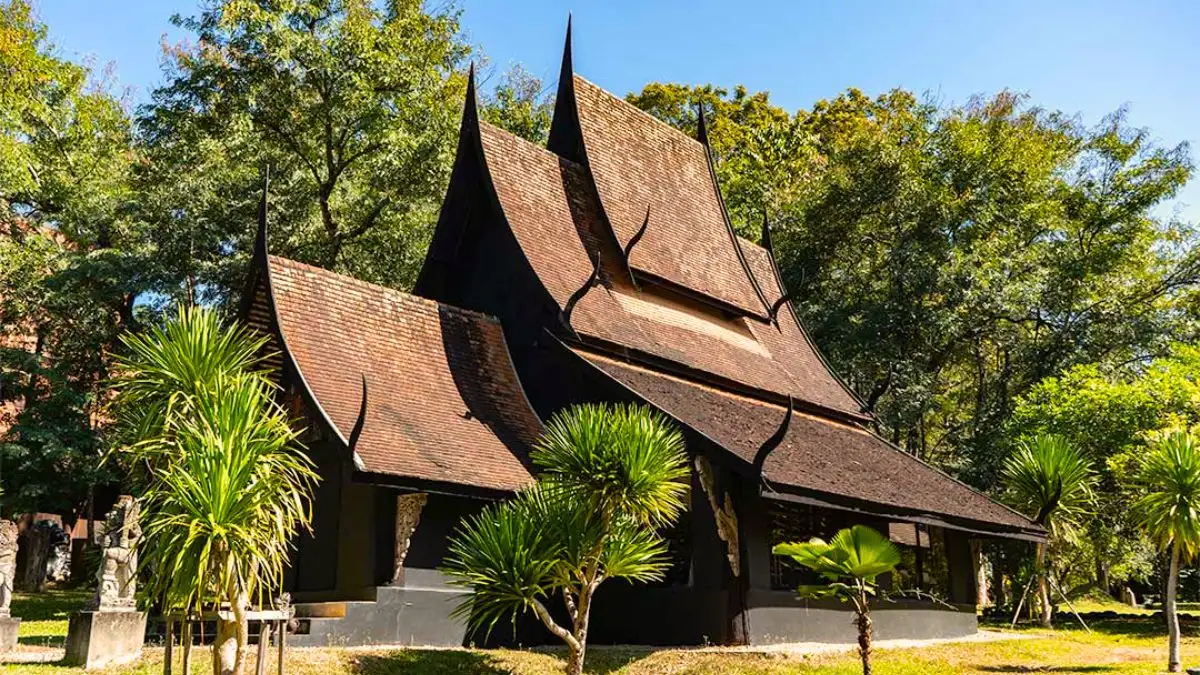
The Baan Dam Museum, also known as the Black House, is an eclectic and fascinating place to visit in Chiang Rai. Created by the late Thai artist Thawan Duchanee, this museum consists of a collection of black-painted buildings and exhibits that showcase the artist’s unique vision. The dark and mysterious aesthetic of the Black House is filled with art, sculptures, and animal bones, all contributing to an eerie yet captivating atmosphere.
The museum blends Thai and modern art in a way that challenges conventional norms, making it a must-see for art lovers and those intrigued by the creative mind of Thawan Duchanee.
- Highlights: A series of dark, eerie structures with unsettling artworks, including animal bones and taxidermy.
- What to Do: Explore the museum’s various buildings, each showcasing the unique art of Thai artist Thawan Duchanee. Take a guided tour to understand the deeper meaning behind the exhibits.
- When to Visit: Morning to enjoy the museum in a quieter environment. Avoid visiting on weekends when it’s busier.
Doi Tung Royal Villa
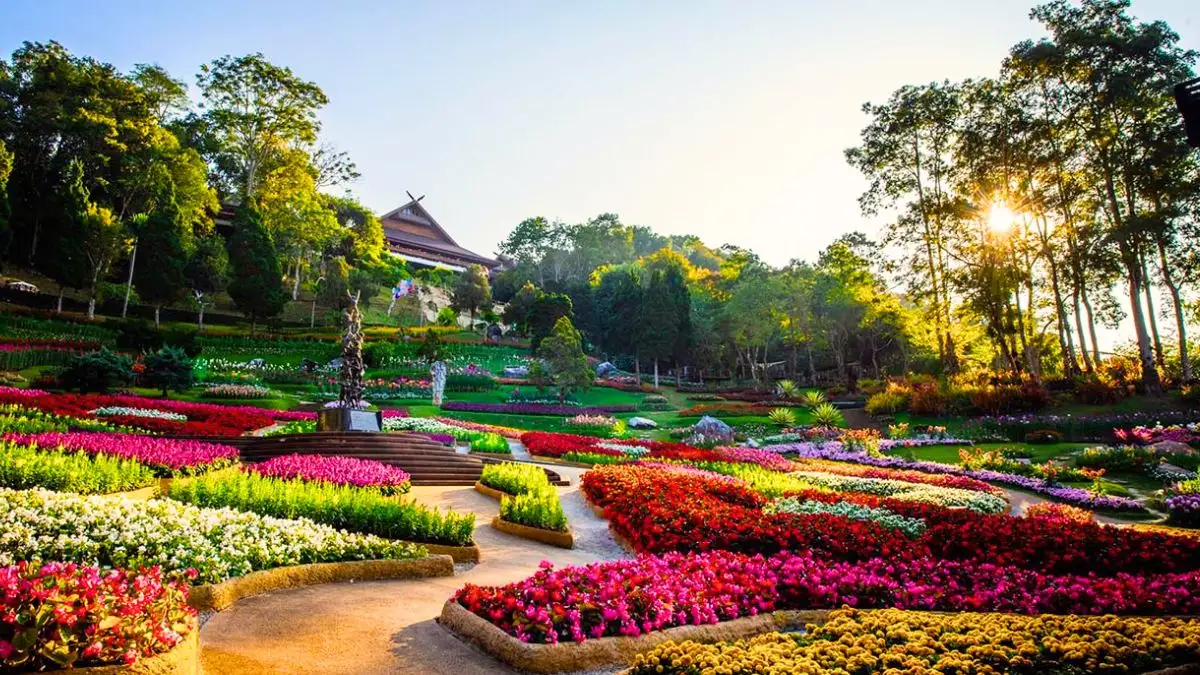
Located on the slopes of Doi Tung Mountain, the Doi Tung Royal Villa is one of the must-visit places to visit in Chiang Rai. It was the former residence of the Princess Mother, the mother of King Bhumibol Adulyadej. The villa, which is now open to the public, showcases a beautiful blend of Swiss and Thai architectural styles. Visitors can stroll through the well-manicured gardens and enjoy panoramic views of the surrounding mountains.
The Doi Tung Royal Villa also provides insight into the Princess Mother’s efforts to improve the lives of local farmers in the region. The nearby Doi Tung Development Project promotes sustainable agriculture, and visitors can purchase locally grown coffee and handicrafts as souvenirs.
- Highlights: A beautiful blend of Thai and Swiss architectural styles nestled amidst lush gardens and scenic views. The villa’s history is deeply intertwined with the Doi Tung Development Project.
- What to Do: Explore the gardens, visit the royal villa, and enjoy the panoramic views of the mountains. Learn about the local hill tribes and the royal family’s legacy.
- When to Visit: Morning for cooler weather and fewer tourists.
Choui Fong Tea Plantation
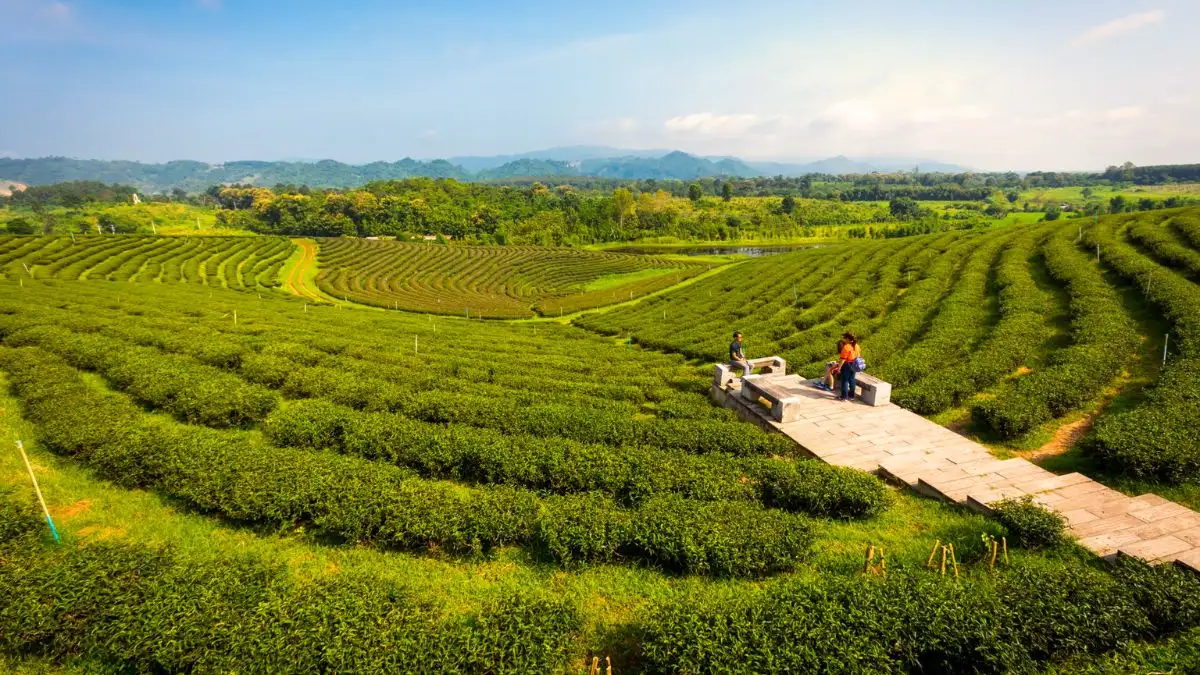
For a peaceful retreat, visit the Choui Fong Tea Plantation, one of the top places to visit in Chiang Rai. Located in the lush hills of Chiang Rai, the plantation is one of the largest in northern Thailand, offering scenic views of rolling hills covered in tea plants. You can take a walk through the plantation, learn about the tea production process, and enjoy a cup of freshly brewed tea while soaking in the peaceful atmosphere.
The Choui Fong Tea Plantation is an excellent spot for those looking to unwind and enjoy nature, with the added bonus of tasting high-quality Thai tea.
- Highlights: Stunning tea fields set on rolling hills with a panoramic view of the mountains.
- What to Do: Visit the tea plantation, sample locally grown tea in the café, and take a walk through the plantation to learn about the tea-making process.
- When to Visit: Morning or early afternoon, particularly during harvest season, for a chance to see the workers in action.
Singha Park
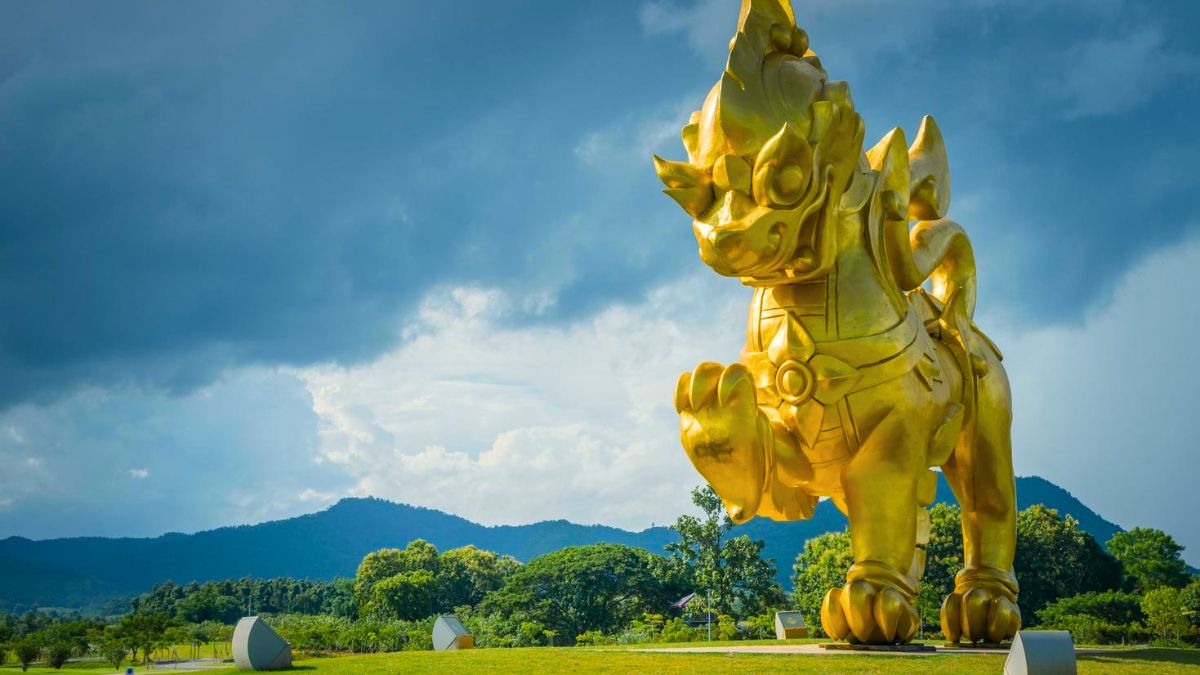
Singha Park is another beautiful location for nature lovers, offering lush greenery and picturesque landscapes. The park spans over 8,000 acres and is home to a variety of agricultural activities, including tea, fruits, and flowers. Visitors can take a leisurely bike ride or enjoy a tram tour of the park, which also features a giant statue of a lion, the symbol of Singha Beer.
Singha Park is an ideal spot for a day trip, offering various activities such as zip-lining, hot air balloon rides, and a chance to learn about sustainable farming practices.
- Highlights: A vast 8,000-acre park offering a combination of tea plantations, flower gardens, and recreational activities.
- What to Do: Take a cycle tour of the park, enjoy a zip-line adventure, take a hot air balloon ride, or visit the Singha statue.
- When to Visit: Morning or late afternoon for cooler temperatures and to catch the balloon rides at sunrise or sunset.
Wat Phra Kaew
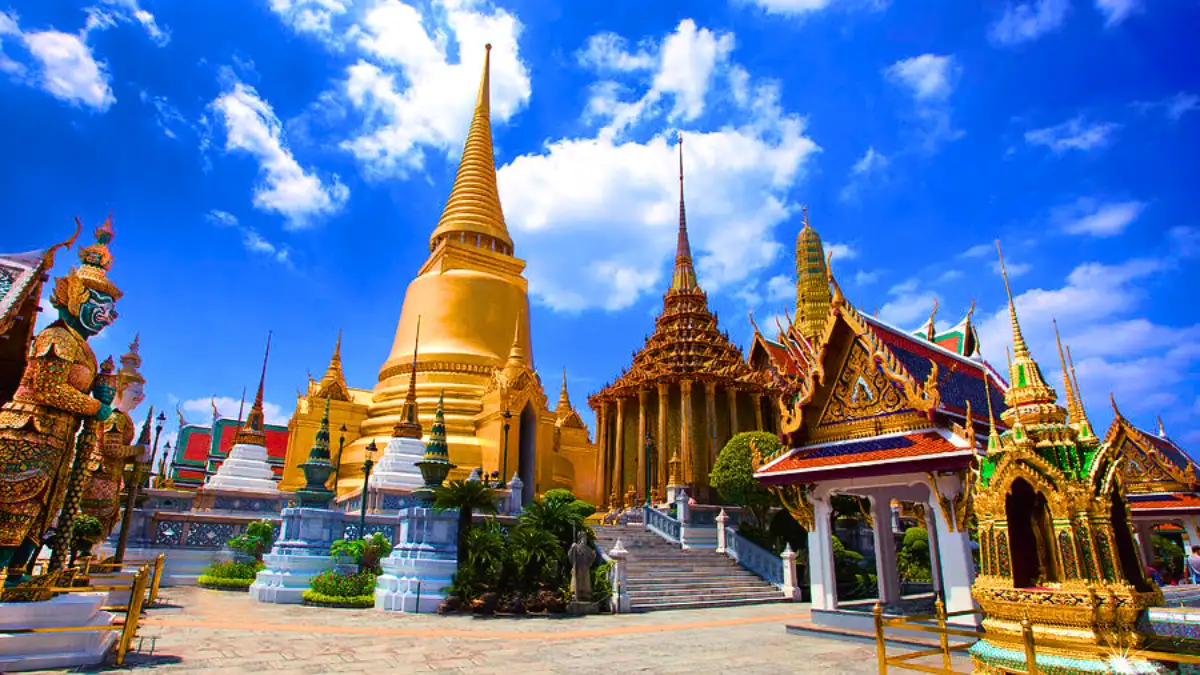
Wat Phra Kaew, located in the city center of Chiang Rai, is a historic temple that was once home to the Emerald Buddha, Thailand’s most revered religious artifact. Although the Emerald Buddha was moved to Bangkok in the 18th century, the temple remains a significant site for both religious and historical reasons.
The temple’s serene ambiance and beautiful architecture make it a worthwhile stop. It is especially popular for those interested in learning more about the spiritual and cultural history of Thailand.
- Highlights: This historic temple is the original home of the Emerald Buddha, one of Thailand’s most revered artifacts.
- What to Do: Explore the Lanna-style architecture, view the mural paintings, and meditate within the peaceful temple grounds.
- When to Visit: Morning is the best time to avoid the heat and crowds, giving you a peaceful visit.
Also Read: Places to Visit in Pattaya
Mae Fah Luang Garden
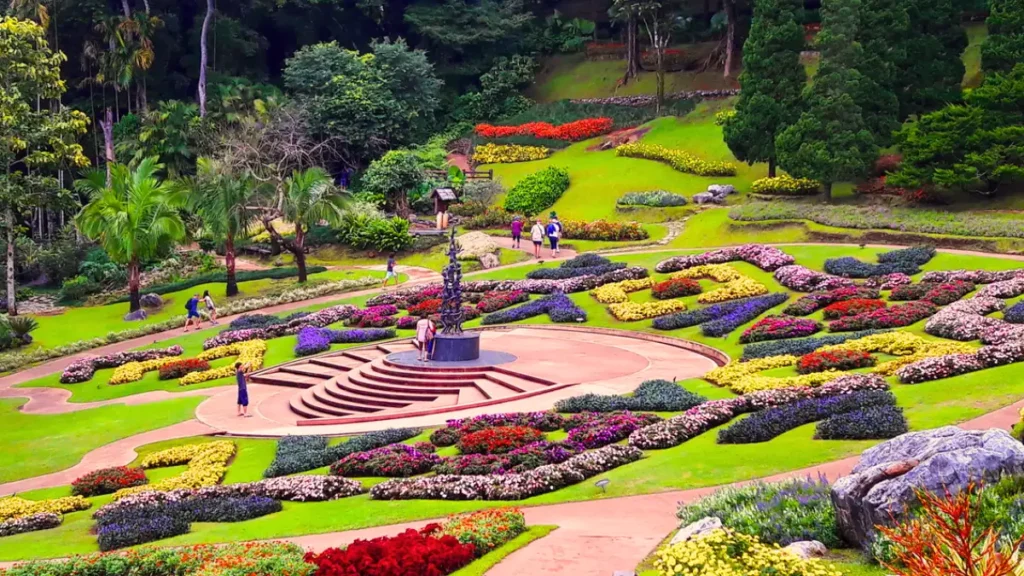
For a tranquil experience, the Mae Fah Luang Garden is a beautiful and well-maintained garden located on the slopes of Doi Tung Mountain. The garden is a testament to the efforts of the Princess Mother to create a peaceful and sustainable environment in the region. The garden features a wide variety of flowers, plants, and trees, and visitors can take a peaceful stroll while enjoying the fresh air and scenic views.
- Highlights: An expansive garden set amidst the Doi Tung mountain range, featuring a variety of tropical plants and flowers.
- What to Do: Explore the flower gardens, take a walk through the orchid section, and visit the viewpoints for stunning vistas.
- When to Visit: Morning for a pleasant climate and fewer crowds. It’s ideal during the cooler months, from November to February.
Wat Huay Pla Kang
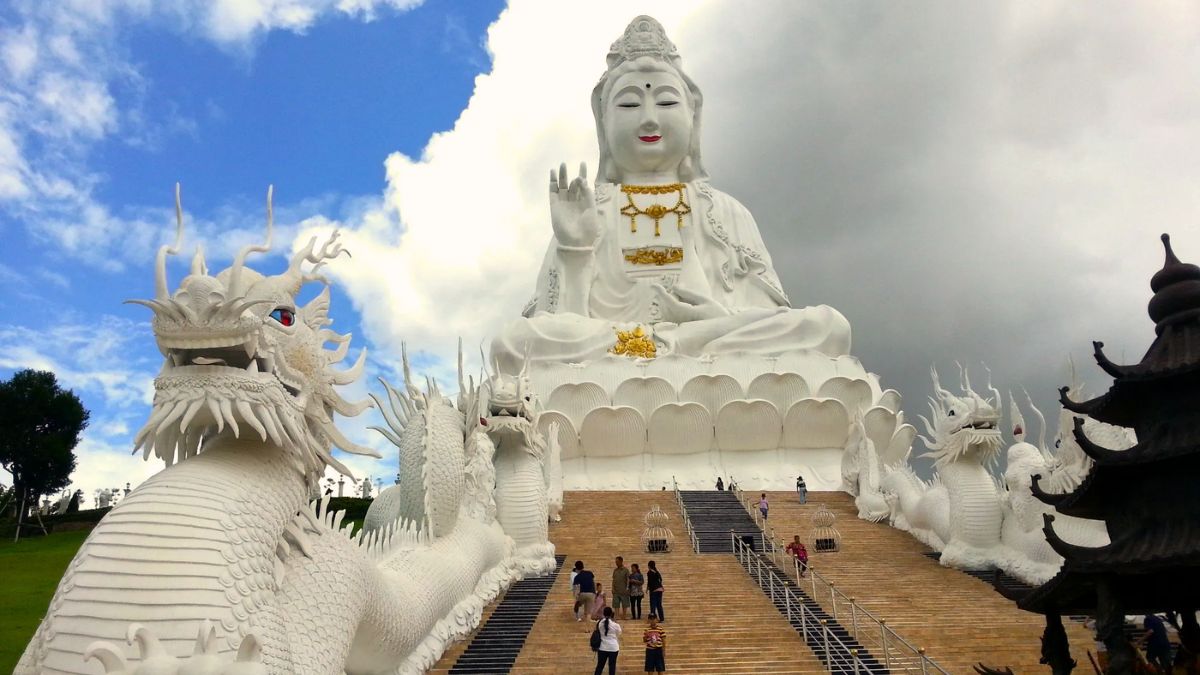
The Wat Huay Pla Kang is a must-visit place to visit in Chiang Rai, located about 15 kilometers from the city center. The temple is most famous for the towering Guan Yin statue, which stands at an impressive 69 meters tall. Visitors can climb the stairs inside the statue to reach a viewing platform, where they can enjoy panoramic views of the surrounding area.
The temple itself is equally beautiful, showcasing traditional Thai architecture and serene grounds, making it an ideal spot for meditation and reflection. The peaceful atmosphere provides a perfect setting to connect with nature and spirituality.
- Highlights: The towering 69-meter Guan Yin statue, offering panoramic views of the surrounding countryside.
- What to Do: Climb the stairs inside the Guan Yin statue to reach the viewing platform. Visit the temple complex, featuring a serene environment for meditation.
- When to Visit: Early morning or sunset to capture the best photos with the light filtering through the statue.
Chiang Rai Clock Tower
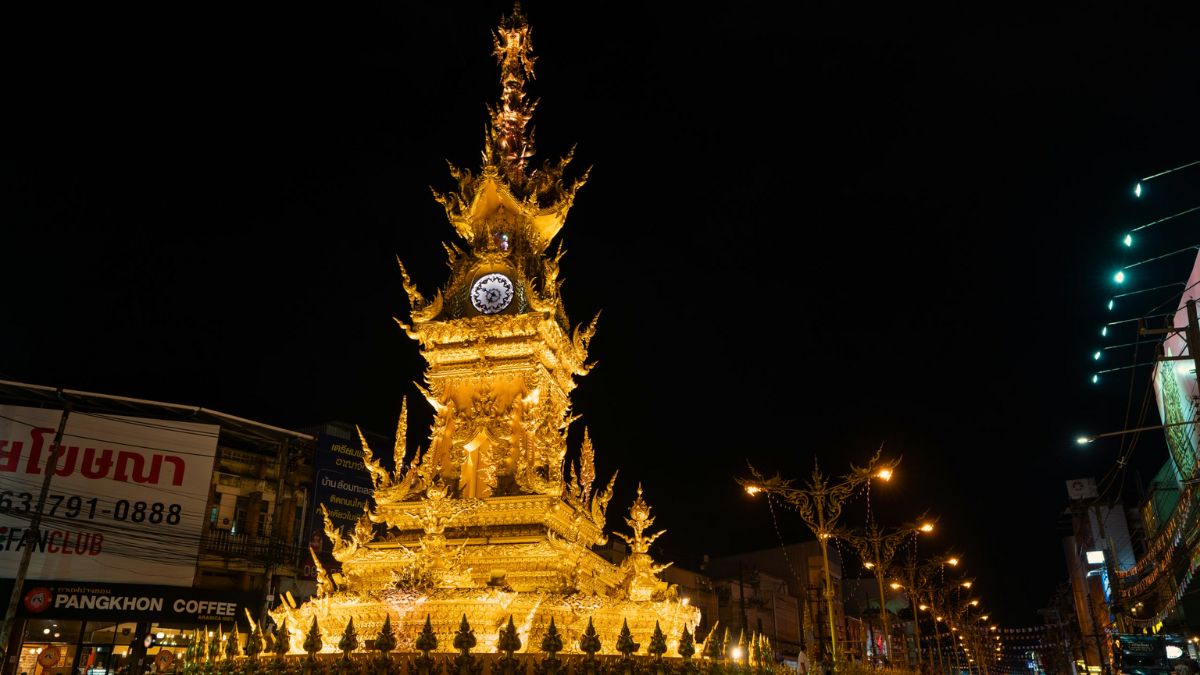
The Chiang Rai Clock Tower is a remarkable golden landmark located in the city center, crafted by Chalermchai Kositpipat, the renowned artist behind the White Temple (Wat Rong Khun). This stunning monument blends traditional Thai art with contemporary design, making it a striking feature both day and night. It not only serves as a traffic circle but also as a cultural and artistic highlight of the city.
- Highlights: A golden masterpiece by Chalermchai Kositpipat, featuring intricate Lanna-style art and evening light-and-music shows.
- What to Do: Watch the light show (7:00 PM, 8:00 PM, 9:00 PM), take photos, and explore nearby shops and cafes.
- When to Visit: Evening for the light show or daytime for detailed views.
Monkey Temple (Wat Phra That Pha Ngao)
Nestled atop a hill, Wat Phra That Pha Ngao, also known as the Monkey Temple, is one of Chiang Rai’s hidden gems. The temple offers sweeping panoramic views of the surrounding mountains, valleys, and lush forests, providing a breathtaking backdrop for visitors. Its name comes from the large population of monkeys that freely roam the temple grounds, offering a playful contrast to the tranquil atmosphere. The monkeys are not only a highlight of the visit but also part of the unique charm of the temple, making it an unforgettable experience. The serene environment, combined with the distant sounds of nature and the presence of the monkeys, creates an ideal place for reflection, relaxation, and enjoying the beauty of the surrounding landscape.
Highlights
- Panoramic views of the surrounding landscape.
- A large population of monkeys that interact with visitors.
- The serene and peaceful atmosphere of the temple.
What to Do
- Climb the steps to reach the temple and enjoy breathtaking views.
- Observe and interact with the monkeys while being mindful of their behavior.
- Take time to meditate or relax in the tranquil surroundings.
When to Visit: Morning or late afternoon is ideal to avoid the heat and enjoy the best lighting for photos, as well as a quieter experience.
Conclusion
In conclusion, Chiang Rai is a hidden gem in northern Thailand that offers a diverse range of attractions for all types of travelers. From the intricate beauty of the Blue Temple to the tranquil views at Choui Fong Tea Plantation and the awe-inspiring height of the Wat Huay Pla Kang Guan Yin statue, this city is brimming with unique experiences. These places to visit in Chiang Rai showcase the city’s perfect blend of rich history, modern art, serene landscapes, and spiritual retreats, making it a must-visit destination. Whether you’re exploring temples, enjoying breathtaking panoramas, or indulging in local tea, Chiang Rai provides a perfect escape that will leave you with unforgettable memories.
Also Read: Places to Visit in Thailand
Frequently Asked Questions
What is Chiang Rai famous for?
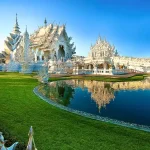
Chiang Rai is renowned for its unique temples like the White Temple (Wat Rong Khun) and the Blue Temple (Wat Rong Suea Ten), its rich Lanna culture, and its scenic landscapes including tea plantations, waterfalls, and mountains.
What is the best time to visit Chiang Rai?
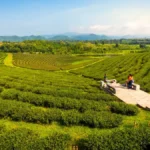
The best time to visit Chiang Rai is between November and February. The weather is cool and pleasant, making it ideal for exploring outdoor attractions and trekking.
How many days are enough to explore Chiang Rai?
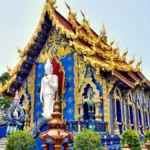
A 2 to 4-day trip is enough to explore Chiang Rai’s major attractions, including temples, the Golden Triangle, tea plantations, and nearby mountains.
Are Chiang Rai attractions family-friendly?
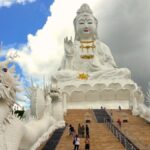
Yes, Chiang Rai is family-friendly with attractions like Singha Park (great for outdoor activities), tea plantations, and educational visits to temples and museums.
Is Chiang Rai a good destination for trekking?
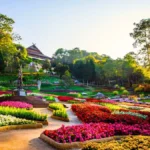
Yes, Chiang Rai offers excellent trekking opportunities, especially in areas like Phu Chi Fa and the surrounding national parks with waterfalls and trails.
What should I wear when visiting temples in Chiang Rai?
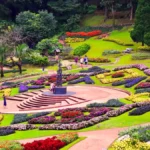
Wear modest clothing that covers your shoulders and knees. Avoid revealing outfits, and always remove your shoes before entering temple areas.

